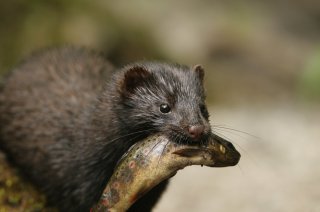
Project
On the merits and pitfalls of introducing a digital platform to aid conservation management
MinkApp: Introducing a digital platform to aid community-based nature conservation management
Volunteers in Scotland monitor the presence of the American mink (Neovison vison), an invasive species which poses a threat to native species. When the volunteers spot traces of mink, they notify the Scottish Mink Initiative and set a trap to catch it. Previously, volunteers recorded their findings on paper. These data would then be sent to the local coordinator, who would compile all the data from all volunteers in the region. The aim of this project is to implement a digital system which works more efficiently and faster. In addition, as a result of the system, volunteers may get immediate feedback as a reward. This happens by means of Natural Language Generation (NLG): computer-written texts on the basis of dynamic datasets. Previously, volunteers would only receive information in a periodic newsletter. Now, they may receive instantaneous feedback, specific to each volunteer’s context. The project also aims to understand the consequences of digitalising volunteer work in nature conservation. Gains in efficiency and decreased costs may have to be weighed against changes in volunteer dynamics.
The platform
The platform was developed by an interdisciplinary team of ecologists, social scientists, computer scientists, and programmers at dot.rural (University of Aberdeen), in collaboration with the Scottish Mink Initiative. The platform takes the shape of a regular website but boasts various additional functions such as the NLG feedback system. Employment of the system beyond the project phase is currently being considered.
The role of the researchers
Firstly, it was important to understand the requirements of the coordinators employed by the Scottish Mink Initiative, who engage with the volunteers. Using various techniques, the researchers mapped and analysed the understandings, expectations, and views of these coordinators. This was then translated into concrete recommendations for software development. In addition, several forms of co-development meetings fed into the platform construction. After various tests and reiterations in terms of platform improvement, the platform went ‘live’ with a controlled experiment involving volunteers using versus not using the system. End-usage analysis was also performed, as well as appreciation surveys of the platform.
Innovative approach
The project is innovative in its interdisciplinary approach. The project brings together a team of computer specialists, ecologists, and social scientists to work on a real-world problem; this may well be an inspiration to many other projects in natural resource management around the world.
The project therefore tackles important questions:
1. How does digital innovation influence people’s relationships with nature and nature management?
2. How can knock-on consequences of the implementation of the digital platform be understood and conceptualised?
3. What role can digital technology play in volunteer retention, and can digital tools – for instance immediate, computerised feedback – stimulate volunteers when there are fewer mink to catch?